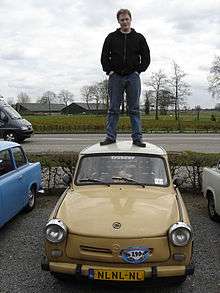Duroplast
Duroplast is a composite thermosetting plastic, a close relative of Formica and Bakelite. It is a resin plastic reinforced with fibers (either cotton or wool) making it a fiber-reinforced plastic similar to fiberglass.

Uses
Duroplast was used by the German Democratic Republic state-owned automobile manufacturer VEB Sachsenring Automobilwerke Zwickau from 1955 until just after German Reunification in 1991. It was the material used to produce the outer body of the Trabant. There were four main versions of the Trabant; the 1963–1990 Trabant 601 was the longest running. The successor company is called HQM Sachsenring GmbH.
The product was first used in the body of the IFA F8 and later also the AWZ P70 or Zwickau P70 and the Trabant. It was also used to make suitcases.
Duroplast is light and strong. It is made of recycled material, cotton waste and phenol resins.[1] Because it can be made in a press similar to shaping steel, it is more suitable for volume car production than fiberglass.
Disposal
Similar to fiberglass, Duroplast has limited possibilities for efficient disposal. As discarded Trabants began to fill junkyards, creative solutions sprung up for disposing of them. One of these was developed by a Berlin biotechnology company, which experimented with a bacterium to consume the body in twenty days.[2][3] Urban legends, depicted in the movie Black Cat, White Cat and described in a song by the Serbian band Atheist Rap, described recycling Duroplast by feeding the cars to pigs, sheep and other farm animals. In the late 1990s, the same Trabant factory in Zwickau developed a solution for disposing of the Duroplast shells by shredding them and using them as an aggregate in cement blocks for pavement construction. This was featured in an episode of the program Scientific American Frontiers on the American PBS TV channel.[1]
Public perception
The use of Duroplast in Trabants and subsequent GDR jokes and mockery in western auto magazines such as Car and Driver gave rise to an urban myth that the Trabant is made of corrugated cardboard.[4]
References
- "Duroplast, on season 4, episode 2". Scientific American Frontiers. Chedd-Angier Production Company. 1993–1994. PBS. Archived from the original on 2006.
- Kumar, Arvind (2004), Environment Contamination & Bioreclamation, APH Publishing, p. 32, ISBN 978-81-7648-587-6.
- Petrány, Máté (13 February 2015). "How Come Duroplast Didn't Become A Thing While Fiberglass Went Big?". Jalopnik. Retrieved 2 July 2015.
- Tony Davis (2005) "Lemon!: Sixty Heroic Automotive Failures", ISBN 1-56025-757-1, Chapter "Trabant P601, p.156-158